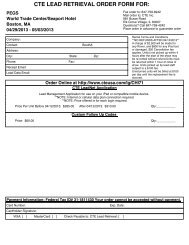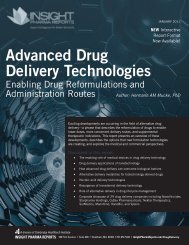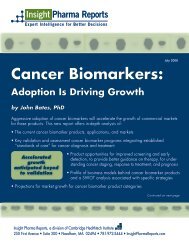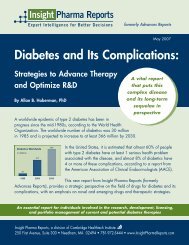2010 Best Practices Competition IT & Informatics HPC
IT Informatics - Cambridge Healthtech Institute
IT Informatics - Cambridge Healthtech Institute
- No tags were found...
Create successful ePaper yourself
Turn your PDF publications into a flip-book with our unique Google optimized e-Paper software.
B. INTRODUCTION/background/objectives<br />
Amylin <strong>IT</strong> set out to move to a flexible technology model that would allow access to world-class <strong>IT</strong><br />
capabilities, without having to operate each of those capabilities. First, the team spent several<br />
months preparing detailed cost analysis for every service they provide. This “cost by service”<br />
model included the labor, licensing, maintenance, hardware, data center cost and even power<br />
usage for each service and application allowed the team to do more accurate comparisons of<br />
costs between delivering services internally or externally.<br />
The result was a list of <strong>IT</strong> services or applications provided by Amylin <strong>IT</strong>, each of which would be<br />
assessed to determine whether the same service could be provided at lower cost through utility<br />
services. Besides cost, other factors were also considered, including security, performance,<br />
architectural appropriateness for the cloud, and vendor capability. Importantly, the team actively<br />
looked for opportunities where SaaS and the Cloud would work, rather than enumerating all the<br />
reasons why cloud doesn’t work.<br />
Amylin built-out a “toolkit” of Cloud and SaaS offerings that their <strong>IT</strong> staff could make use of to<br />
enable flexible <strong>IT</strong>. For Infrastructure as a service (IAAS), they chose Amazon Web Service<br />
(AWS) and vertical offerings built on AWS. For Platform as a Service (PaaS), they use<br />
Force.com. For cloud storage, they started a relationship with Nirvanix. And finally they began a<br />
deep investigation of Software as a Service (SaaS) capabilities to meet their application needs.<br />
In each case, internal <strong>IT</strong> teams would begin pilot projects, have personal “sandboxes”, and get to<br />
understand these capabilities on a technical level. In the case of Amazon, Force.com, and<br />
Nirvanix, initial skepticism turned into a positive response, as the capabilities of these tools were<br />
understood. Getting tools in the hands of technical people was key to gaining their understanding<br />
an buy-in.<br />
C. RESULTS (highlight major R&D/<strong>IT</strong> tools deployed; innovative uses of technology).<br />
As Amylin rolled out their cloud initiatives, they first focused on Amazon EC2 to host a limited<br />
number of application use cases. Amazon EC2 will continue to grow as a hosting platform for<br />
Amylin, and additional migrations are planned for this year and 2011.<br />
Amylin has a number of internal legacy applications, often without the internal resources to<br />
manage or upgrade them. As initial pilot applications were successful, the team is now planning<br />
to move legacy applications to Force.com. The component reusability and rich platform led<br />
Amylin developers to determine they could be more productive in such an environment.<br />
The third focus was storage and disaster recovery capabilities. Rather then building out an inhouse<br />
system, Amylin called upon Nirvanix, a cloud storage partner. Amylin server images and<br />
data is now stored in the Nirvanix cloud, meeting compliance requirements and providing disaster<br />
recovery and backup capability for Amylin’s data.<br />
Finally, Amylin invested significant time understanding the wide range of SaaS offerings<br />
available. Frequently, they discovered that SaaS offerings were more feature-rich and easier to<br />
use than internally hosted applications. Currently, Amylin utilized over a half a dozen SaaS<br />
applications, and migrations to several more are in progress. These include Workday, Microsoft<br />
Hosted Exchange, LiveOffice, and Saba.<br />
Amylin used the following tools (cloud services) to meet their business needs:<br />
Nirvanix: Nirvanix Storage Delivery Network (SDN) for enterprise cloud storage. The project involved<br />
moving critical validated server images that are used for all business and manufacturing applications<br />
and drugs simulation process such as Blast, C‐Path and other genomics simulations. Since these are








